Mounting tennis rackets for wheelchair athletes requires specialized systems that secure equipment without impeding mobility. You’ll need quality clamps, supports, and adaptive grips compatible with chairs like SPEEDY F1 4tennis and RGK GrandSlam models. Implement a six-point mounting technique, focusing on racket alignment and proper weight distribution. Conduct weekly safety checks on all hardware and straps. Regular maintenance prevents damage and guarantees peak performance. The right mounting system can dramatically improve your court coverage and shot execution.
Understanding Specialized Mounting Systems for Wheelchair Tennis
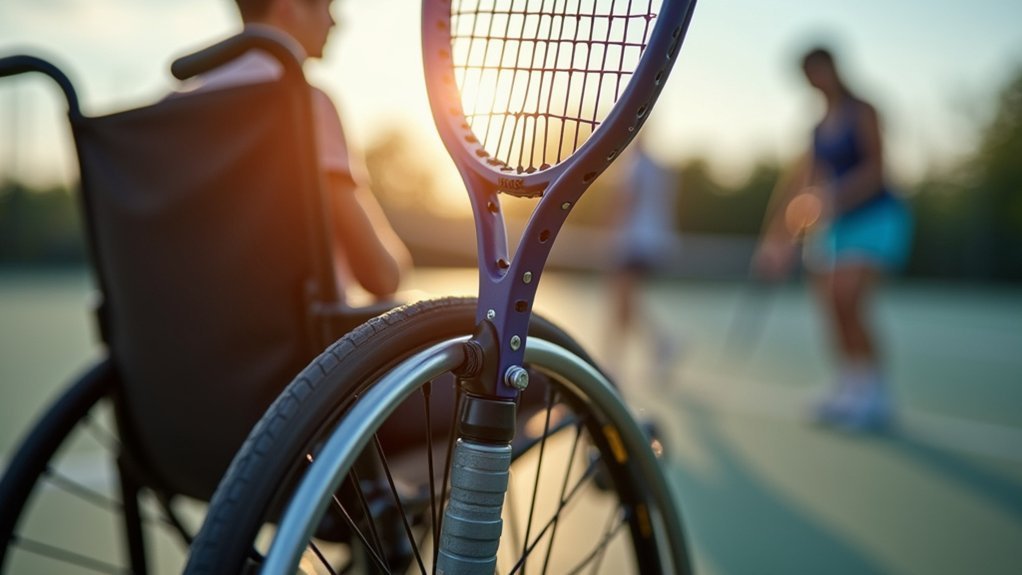
Innovation in wheelchair tennis equipment has created unique challenges for players managing their rackets during competitive play.
Rapid advances in adaptive sports technology present new complexities for wheelchair athletes seeking optimal racket management solutions.
While specialized chairs like the SPEEDY F1 4tennis and RGK GrandSlam offer superior agility on court, they typically don’t include integrated racket holding systems.
You’ll need to evaluate how a mounting system interfaces with your chair’s unique features. Effective mounts attach to side guards or armrests without disrupting your center of gravity or maneuverability.
The best systems secure your racket firmly while allowing quick access when needed.
Look for adjustable mounts compatible with your wheelchair’s materials—particularly important if you’re using a carbon fiber frame.
The ideal mount won’t restrict your movement or vision while maintaining your racket in a consistent, accessible position throughout play.
Essential Tools and Equipment for Racket Mounting
Gathering the right tools makes all the difference when mounting tennis rackets for wheelchair play.
You’ll need basic mounting hardware like clamps and supports alongside specialized equipment designed for adaptive needs.
For best results, verify you have:
- Mounting hardware – Quality clamps and supports secure the racket firmly during installation, preventing damage and guaranteeing proper alignment.
- Adaptive grip systems – Customized for your hand mobility needs, these systems improve control and reduce fatigue.
- Measuring tools – Essential for accurate positioning and consistent performance across multiple rackets.
- Safety equipment – Anti-slip mounts and safety nets protect both you and your equipment during the mounting process.
Don’t overlook vibration dampeners and tension gauges, which help fine-tune your racket for your specific playing style.
Step-by-Step Racket Mounting Technique for Wheelchair Athletes
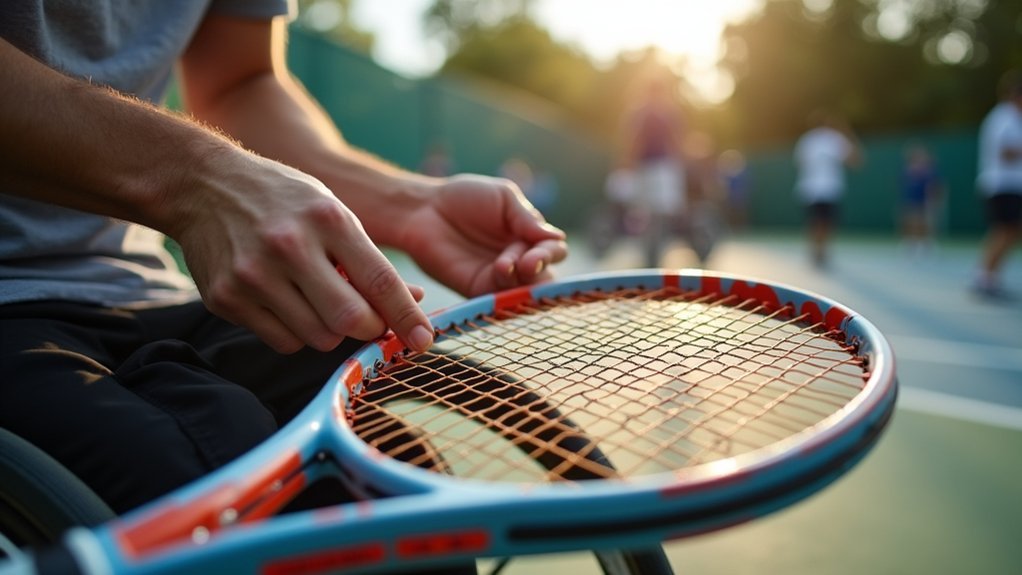
When mounting a tennis racket for wheelchair athletes, you’ll need to implement the six-point mounting system that secures the racket at critical contact areas while allowing proper wrist movement.
You can customize grip adaptations by applying additional tape layers or molded grips that accommodate limited hand function and prevent slippage during play.
These modifications should complement your chair configuration and personal mobility needs, ensuring seamless changes between pushing and stroke production.
Six-Point Mounting System
The six-point mounting system offers wheelchair athletes superior racket stability during the stringing process. This extensive support distributes pressure evenly across the frame, preventing warping while maintaining precise tension throughout your racket.
When using a six-point system, follow these key steps:
- Center your racket on the turntable first, ensuring perfect alignment before applying any pressure.
- Secure the head mounts initially to stabilize the top portion, then progress to the side mounts.
- Position all mounting points carefully to avoid blocking any grommet holes.
- Tighten each mount firmly but not excessively—over-tightening risks frame damage.
Remember to maintain consistent racket orientation throughout the mounting process to achieve uniform string patterns and ideal playability for your wheelchair tennis game.
Custom Grip Adaptations
Every wheelchair athlete requires a uniquely adapted racket grip that accommodates their specific needs and playing style.
When designing your custom grip, focus on maintaining firm racket control without sacrificing wrist mobility or endurance.
The rubber band method offers a flexible, adjustable solution—simply add or remove bands based on your grip strength requirements.
For more advanced adaptations, consider Racket Cords with vertical elastic bands secured by clamps, allowing you to personalize grip tightness even during matches.
Choose grip materials that withstand sweat and environmental conditions while preventing abrasions.
Prioritize ergonomic designs that securely hold your pinky and ring fingers.
Always test initial prototypes for effectiveness and comfort, making modifications based on your feedback to guarantee safety and peak performance across different racket handle sizes.
Customizing Grip Adaptations for Limited Hand Mobility
Many wheelchair athletes with limited hand mobility face unique challenges when gripping a tennis racket, requiring specialized adaptations that blend functionality with comfort.
You’ll find these adaptations are increasingly innovative, featuring elastic bands, modified gloves, and customizable racket cords to secure your hand firmly during play.
When selecting grip adaptations, consider these essential factors:
- Ergonomic fit – Choose grips that accommodate your specific hand size and strength while maintaining natural wrist alignment.
- Material selection – Opt for smooth, durable materials that resist weather conditions and prevent skin abrasions.
- Customization options – Look for adjustable straps and multiple sizing options to guarantee secure finger positioning.
- Ventilation features – Select designs with proper airflow to prevent overheating during extended play.
Maintenance and Safety Checks for Mounted Equipment
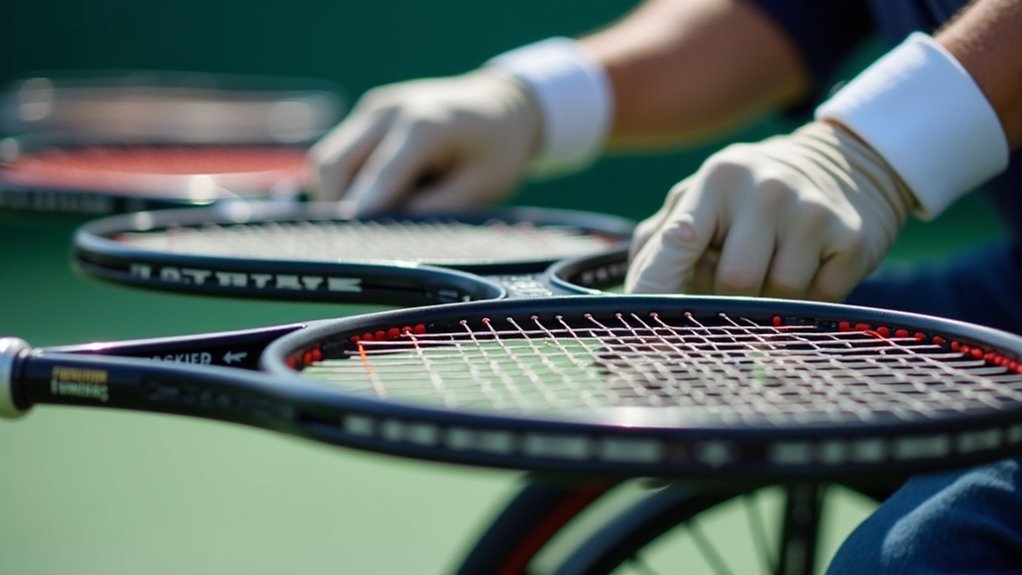
You’ll need to conduct weekly equipment inspections to guarantee your mounted racket remains securely attached and functioning properly.
Check the tension of all mounting hardware and straps before each practice session to prevent accidents and maintain peak performance during play.
Implement a damage prevention protocol that includes cleaning your equipment after use and storing it in a dry environment to extend the lifespan of both your wheelchair and mounted racket.
Regular Equipment Inspections
Maintaining the safety and functionality of mounted tennis rackets requires systematic and thorough inspections.
You’ll need to establish a regular inspection routine that addresses all components of your mounted equipment system.
- Frame integrity – Check weekly for cracks, warping, or material degradation, especially with older frames that may be more susceptible to stress from mounting mechanisms.
- Grip condition – Examine grips every 2-3 weeks for wear, moisture damage, or bacterial buildup that could affect your hold during play.
- Mounting hardware – Verify all clamps, fittings, and locking mechanisms are secure before each session to prevent equipment movement. Finding joy in everyday activities like equipment maintenance can transform this routine task into a meaningful part of your athletic journey.
- Storage practices – Document your maintenance schedule and store equipment in temperature-controlled environments using protective cases when transporting to extend equipment life.
Tension Safety Checks
The integrity of your string tension represents one of the most critical safety aspects of wheelchair tennis racket maintenance. You’ll need to regularly monitor how your strings respond to playing conditions, as tension loss can affect both performance and safety.
| Tension Level | Benefits | Safety Considerations |
|---|---|---|
| Lower (44-50 lbs) | More power, less strain | Better for beginners, reduces injury risk |
| Medium (50-55 lbs) | Balanced performance | Suitable for most players, requires regular checks |
| Higher (55-60 lbs) | Enhanced control | Increases arm strain, needs more frequent inspection |
Don’t overlook environmental impacts—heat and humidity accelerate tension loss. Implement pre-game checks and post-play evaluations to maintain ideal setup. For polyester strings, consider stringing 2-4 pounds lower than nylon to prevent excess stiffness while preserving control.
Damage Prevention Protocol
Implementing a thorough damage prevention protocol guarantees your mounted tennis equipment remains safe and functional throughout competitive play.
Regular inspections will help you identify potential issues before they lead to equipment failure or safety hazards during matches.
To maintain ideal equipment condition:
- Check mounting brackets weekly for signs of loosening or wear—tighten all fasteners and replace any damaged components immediately.
- Inspect racket attachment points after each session, ensuring they’re secure and properly aligned with your body mechanics.
- Examine all cables and straps monthly for fraying or stress damage, particularly at connection points.
- Test the overall stability of your setup by simulating gameplay movements in a controlled environment.
Don’t overlook weight distribution issues, as improper balance can compromise your wheelchair’s stability and increase tipping risk during aggressive play.
Integrating Racket Systems With Sport Wheelchairs
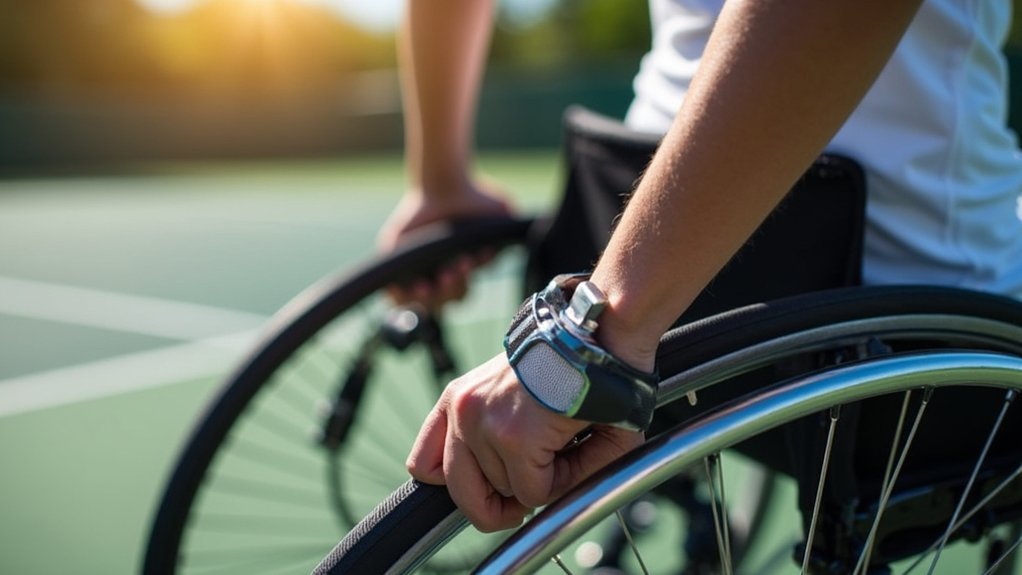
Successful integration of racket systems with sport wheelchairs requires a delicate balance between functionality and player comfort.
You’ll need to evaluate weight distribution carefully, ensuring the mount doesn’t compromise your chair’s stability or mobility during play.
Select mounting systems that offer adjustable tilt angles to optimize your shot execution while maintaining proper ergonomics for your specific needs. The mount should attach securely without interfering with your propulsion technique—a critical factor in maintaining efficiency on court.
Choose mounting systems featuring adjustable angles for optimal ergonomics without compromising your wheelchair propulsion mechanics on court.
When integrating your system, prioritize designs with impact absorption features to reduce vibration transfer during shots.
Look for options that allow easy maintenance access and quick removal for travel. The best solutions emerge from collaboration between manufacturers and athletes, incorporating feedback to refine designs that enhance performance while accommodating varying disabilities.
Advanced Mounting Techniques for Competitive Play
As competitive wheelchair tennis demands precision and consistency, advanced mounting techniques have evolved to give athletes a significant performance edge.
You’ll find these techniques focus on optimizing your racket’s performance while maintaining wheelchair stability and maneuverability.
For maximum competitive advantage, consider these essential mounting strategies:
- Stroke-specific configurations – Adjust your mounting to enhance forehand power, backhand control, and serve efficiency.
- Customized grip solutions – Implement adaptive grip adjustments and thumb supports that match your unique playing style.
- Strategic weight distribution – Balance your racket to improve maneuverability while reducing vibration and strain.
- Safety-conscious fastening – Secure your racket with ergonomic systems that protect your wrist and shoulder during intense play.
These techniques will dramatically improve your court coverage and shot execution during tournament play.
Technological Innovations in Adaptive Tennis Equipment
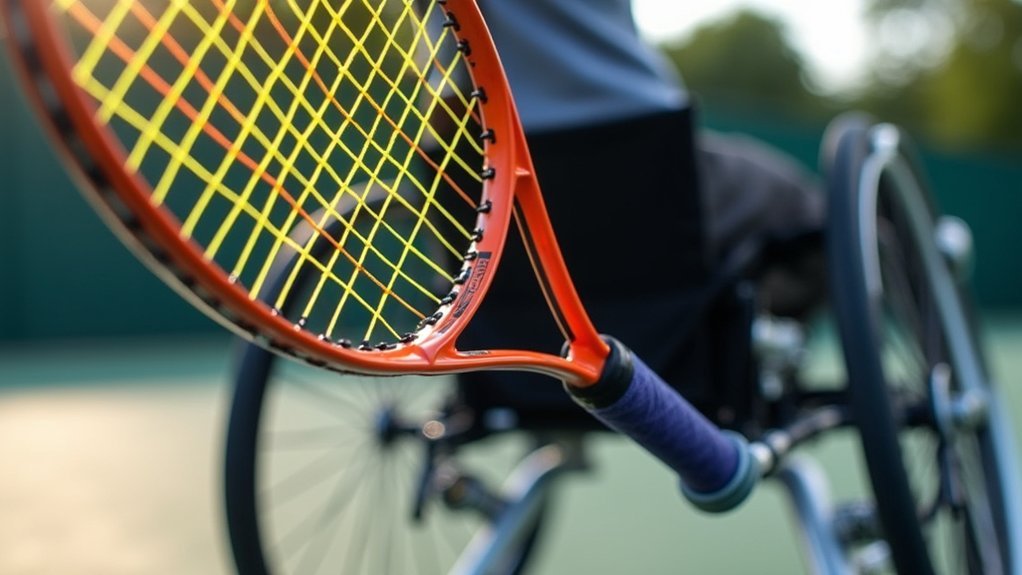
The rapidly evolving landscape of adaptive tennis equipment has revolutionized how wheelchair athletes approach the game. 3D printing now enables customized, lightweight prosthetics specifically designed for tennis movements, while AI-powered systems adjust to your real-time performance needs.
Today’s sport wheelchairs feature cambered wheels for quicker turns and lightweight materials that enhance maneuverability on court. Anti-tip caster wheels prevent accidents during aggressive serves, while specialized hand rim covers improve your grip and control.
For players with various abilities, modified tennis equipment includes audible balls containing ball bearings for visually impaired athletes and optimized racket grips that secure your hand without restricting movement.
Automatic serving systems using compressed air technology help you deliver effective serves despite limited mobility.
Frequently Asked Questions
Can Weather Conditions Affect Adaptive Grip Materials?
Yes, weather can affect your adaptive grip materials. Rain can make leather slippery, UV light degrades rubber, and temperature extremes alter gel’s properties. You’ll need materials that maintain grip in your specific conditions.
How Often Should Wheelchair Athletes Replace Their Custom Grips?
You should replace custom grips when they lose tackiness or show wear. Generally, replace them as often per month as you play per week, but your specific needs and weather conditions may require more frequent changes.
Are There Transportation Cases Designed for Mounted Rackets?
Few cases are specifically designed for mounted rackets. You’ll likely need to modify standard racket cases or create custom solutions that protect your equipment while integrating with your wheelchair transportation system.
Can Adaptive Mounts Transfer Between Different Racket Sports?
Yes, you’ll find most adaptive mounts are designed for versatility. They feature universal compatibility, interchangeable components, and tubing size adaptability that lets you transfer them between tennis, badminton, table tennis, and other racket sports.
How Do Mounting Techniques Differ for Children Versus Adult Wheelchair Athletes?
Children need smaller, lighter mounts with rubber or silicone grips that you’ll adjust more frequently as they grow. You’ll find adults require more personalized, high-tech mounting systems with advanced features for peak performance.
In Summary
You’ve now got the tools and knowledge to properly mount your tennis racket to your wheelchair. Remember, your setup should reflect your unique abilities and playing style. Don’t hesitate to experiment with different positioning and attachments as you progress. Regular maintenance checks will keep your equipment safe and performing at its best. With the right mounting system, you’ll enhance your game and experience greater freedom on the court.

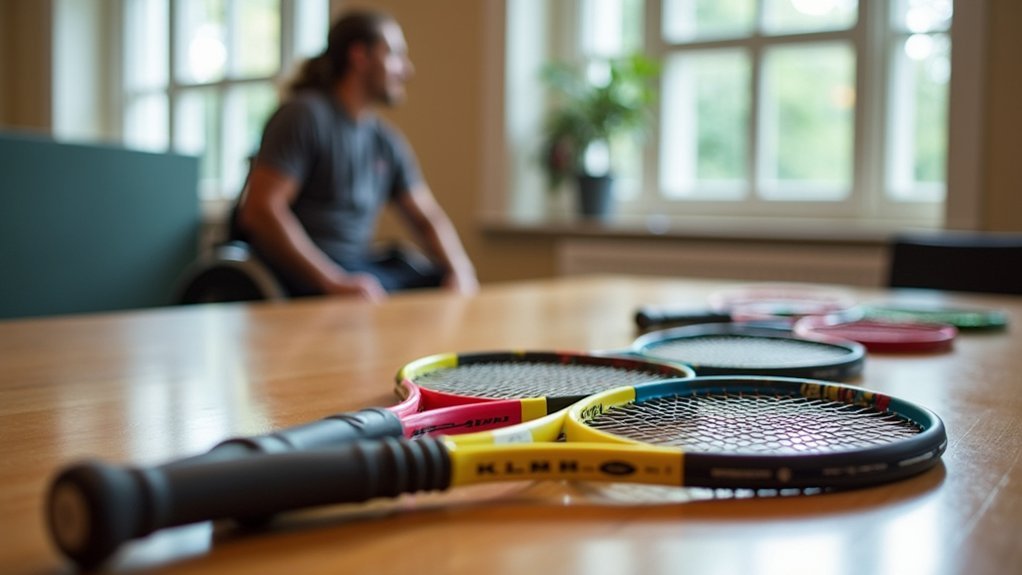



Leave a Reply